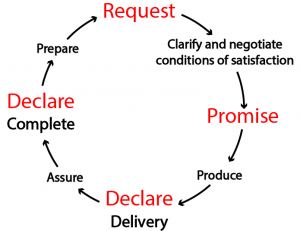For commitments to be effective, they require an ongoing dialog between the customer/requester and the performer. That dialog follows a closed-loop structure that proceeds through four distinct steps – Preparation, Negotiation, Execution, and Acknowledgement – in which each party has certain responsibilities.
1. Preparation
Requester: Identifies the single best performer for the task and makes a specific request that includes the time, quality and cost, as well as the rationale for the request.
Performer: Spends the time needed to fully understand the customer’s concerns.
2. Negotiation
Requester: Makes sure the performer understands the request. Negotiates and agrees to the conditions of satisfaction. Understands and agrees to what the requester needs to do to enable the performer to accomplish the task.
Performer: Makes sure they understand the request and realistically assesses their ability to execute. The performer states what they need from the requester, anything, in order to accomplish the task.
Outcome: The performer makes a promise which the requester accepts. An explicit agreement is confirmed as to an outcome and due date.
3. Execution
Requester: Monitors progress of work and delivers on any agreed actions to the performer. If the requester becomes aware of a change in circumstances that relate to the agreed task, the requester promptly advises the performer and renegotiates a new agreement in good faith.
Performer: Updates the requester regularly on progress. If the performer perceives they may break the original agreement, they promptly notify the requester of the change in circumstances and renegotiate a revised agreement in good faith. If needed, renegotiation occurs before the original due date has passed.
Outcome: At the conclusion of this phase, the performer assesses that the task is complete and makes a delivery to the customer.
4. Acknowledgment
Requester: Assesses the performer’s work against the terms of the agreement and provides feedback and rewards (when appropriate). Any lessons learned for improvement for the next project are articulated.
Performer: Inquires about the customer’s satisfaction and solicits feedback. Any lessons for improvement are incorporated for the next project.
Outcome: The requester declares the work is satisfactory (or not). Note: It is up to the requester to determine if the task is done, not the performer. The loop is closed; the commitment cycle is complete.
Commentary
The commitment cycle outlined above is straightforward, even obvious. Unfortunately, however, it is rarely followed and commitments are weak or non-existent most of the time. Requests are poorly articulated. Clear agreements are replaced with statements from performers like “I’ll try my best” or “I’ll put a top priority on this”. Sometimes tasks are just “assigned” without any commentary at all from the performer as to their ability to perform. Often dialog breaks down during execution, especially when things go wrong. Deadlines slip without acknowledgment and renegotiation. Deliveries are “slid” in without announcement and acknowledgements are rare. A lack of attention to the four stages of a commitment cycle results in enormous waste in an organization’s productivity. Even more important, interpersonal relations are strained and trust declines.
Organizations that embrace the culture and practice of making effective commitments will save costs and outpace their rivals. CommitKeeper is a software tool that guides users through the four stages of a commitment cycle and reinforces best practices.

